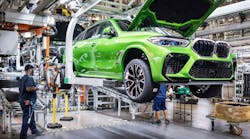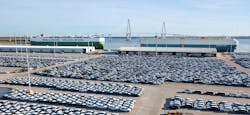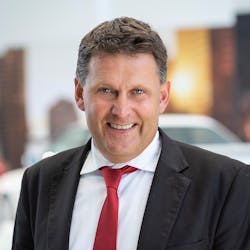‘We Transform While We Perform’: BMW Spartanburg Revs Up for the Shift to Electric
More than 30 years ago, the once-proud textile hub of Spartanburg, South Carolina, was selected as the site for BMW’s new U.S. assembly plant. This was a big announcement back in 1992 ($600 million investment, 2,000 new jobs), but it’s unclear anyone back then had an idea just how big the plant would become and how much of an economic impact it would have.
Now BMW’s largest plant worldwide, the Spartanburg plant (aka BMW Manufacturing Co. LLC) has been expanded six times. Its 11,000 workers together make up 4.8% of all manufacturing jobs in the state, and nearly 90% of the plant’s supply base is local. More than 1,500 new BMWs a day roll out of the site, six days a week, with a large percentage of those “Bimmers” headed three hours southeast to the Port of Charleston for export to Europe and Asia.
The are even bigger things coming. BMW Spartanburg currently produces nine gas-powered models (X3-X7 and the M models) and two plug-in hybrids, but it is revving up to make six new electric-vehicle models for 2026—on the same assembly line as the gas and hybrid vehicles. The plan includes a $1 billion investment in the existing facility and $700 million high-voltage battery assembly facility about 50 miles south in the city of Woodruff.
While construction is happening, the plan is for production to continue apace. The existing Spartanburg assembly line has an unconventional "finger" configuration, planned 12 years ago with growth and expansion in mind. Each finger on the "hand" (the full building) is a corridor, and the assembly line flows up and down each corridor (as if you’re tracing the fingers on your hand). Small batches of parts are delivered to the exact points where they are needed on receiving docks that line each corridor. The “palm” on the hand houses testing and inspection, administrative offices and a cafeteria. The setup allows for less inventory on the line, and more efficiency of space.
Flexibility is also a theme in BMW Spartanburg’s new training campus—the only BMW training hub in the Western Hemisphere—where classroom spaces are flexible, robot cells are on moveable pallets and wi-fi extends to outdoor learning areas. A room might house robotics classes one day and German language instruction the next. Work cells simulate the production environment, to the point where when the plant gains new machinery, an identical machine is purchased for the training center. Augmented and virtual reality are used to train roles that have additional safety restrictions, like high-voltage battery assembly.
Leading the plant’s expansion is Robert Engelhorn, BMW Manufacturing’s president. Engelhorn took the helm of Spartanburg in 2021, after stints in Ravensburg, Germany, and China. He also lead the launch of the i4 EV in Munich, assembled there on the same line as the plug-in hybrid.
“Every day is exciting,” says Engelhorn of the atmosphere at Spartanburg. “I am quite pleased with how the team has been able to adapt [to the transformation.] I’m excited about the spirit, the motivation of our people going the extra mile.”
Engelhorn talked with IndustryWeek about what’s ahead for Plant Spartanburg.
IndustryWeek: Where are you at with the expansion and upgrades to Spartanburg?
Engelhorn: We just completed and opened a new logistics center to have the parts closer [to the production line] in preparation for the upcoming new vehicle generations. It is a $100 million investment that utilizes autonomous logistics and supports the installation of a future rooftop solar photovoltaic [power] system. It allowed BMW to consolidate two warehouses and their material into one building.
The new stamping plant, which will allow us to do the sheet metal parts ourselves, is in commissioning. The excavation has started for the assembly expansion and new battery facilities.
How will EVs fit into not just your plant’s blueprint, but its future?
We believe in the growth of electric mobility. But we also believe that the other drive trains are still viable for the next 5, 10, 15 years. They are suitable for customer demands. And therefore, the key for us is to be flexible and to react to these different customer demands on a worldwide basis.What’s exciting, maybe also quite unique, about the business model here in Spartanburg is that out of 400,000 cars, 60% of our volume is exported through the Port of Charleston. We have a big customer base in Germany, in Korea and China, and therefore we have to address the different customer demands on worldwide basis and not specifically here in USMCA. We also use complex camera systems, human visual verifications and, very soon, AI solutions to make sure we meet all governmental regulations and standards [in different parts of the world].
Having said this, with regard to the investment, it’s up to us now to integrate and run production of these new electrified models here in the plant. We transform while we perform, and we have huge transformation, huge construction activities here on-site while producing.
Is flexibility happening within the plant while you’re expanding?
We can assemble combustion-engine, plug-in hybrid and fully electrified vehicles across one line. At the moment we have on our lines the X3 to X7 models and the XM. We have the X3 plug-in hybrid and X5 plug-in hybrid and from the X3 to X6. We have also the M derivatives on the line. One of the key issues here for us is handling all of this complexity because a huge portion of the customers are pre-order, pre-spec, and then it's up to us to build according to the customer demands. Not only the engine—it's about the color, the interior and working with suppliers to make the specific customer demands happen.
How do you build a pipeline of people to work in high-level production jobs?
Car production is a team sport and people business. We need really motivated, trained and skilled workers. Therefore, for us, it's important to really have high employee satisfaction with a good work environment, good compensation and really taking care of our people with skills training, recognition, reward and engagement. Upskilling in our training center helps to make sure that our plant family remains part of the company but are given new tasks, ensuring that our people are driven to stay with us long-term.
The skills we needed before remain essential today; however, due to digitization, demands on sustainable production and the EV transformation, we have had to pivot to include more advanced robotics and items like AR/VR and lasers. We are still building cars, but they are being built differently at almost every touchpoint.
In some areas that are highly optimized, we need a very high skill level from our people. We have to build that ourselves to a large extent, to have the right people. In addition, it’s best to have a close collaboration with colleges and universities to attract the right people on the different levels that we need specifically. We work with many academic institutions but have a very close relationship with Clemson [University] as well as with Spartanburg Community College and through our BMW Scholars Program [a two-year apprenticeship for students at area technical colleges].
What technologies are key for the high amount of flexibility you have in your plant?
By redefining the future orientation and processes of the plant, we are adding new standards for flexible, efficient, sustainable and digital manufacturing technologies. Our production system is becoming even more precise, transparent and faster thanks to meaningful real-time data on the entire production process. This enables production to spontaneously cushion supply bottlenecks and react extremely flexibly to fluctuations in demand. What this means for our customers is that they can still change the configuration of the vehicle they’ve ordered up to six days before production starts.
But flexibility also depends on our suppliers having the right people, the right engineers on site to develop and industrialize parts. Eighty percent of our parts are coming from outside the plant. So being able to cope with the supplier network mainly in the U.S. and abroad is vital. Then, inside the plant, logistics plays a major role. If you can imagine having in- and outbound logistics for 1,500 vehicles on a daily basis—it’s quite crucial, having the right quality, the rights parts on time and on the line.
It’s also crucial to have the right people running our facilities on the control side, the maintenance side and the leadership side. But in addition, it’s important to have the right skilled people in electric mobility. For the battery electric drive train, starting from the battery cells, the battery assembly up to the completed vehicle, you for sure need different skills than for combustion-engine cars.
What distinguishes the Spartanburg plant?
It all starts with the right skills and a motivated team. Right now we are in one of our biggest transformations. Nobody has 100% clear view which outlook and to what extent change will happen. Coping with uncertainties and new challenges daily is key. With fierce competition, you have to do it better than your competitors.
In addition, we have a very good, attractive existing lineup. Working on delivering those cars gives you a big lever, and anticipating also what's happening in the future and embedding that in your production network. You have to anticipate and you have to decide and cope upfront with structural measures in terms of flexible response. We also have colleagues working out of Germany or China launching this new vehicle lineup. But here specifically in Spartanburg, we have to think about what we might offer. How can we set up ourselves in flexible ways structure-wise, for what might happen in the next couple of years?
What new technology in the plant is particularly fascinating to you or a game changer?
We are front and center within the BMW Group when it comes to innovation and digitalization. We are leveraging new technologies to design and implement the upcoming launches of the next-generation X models. To name a few: NVIDA Omniverse [3D workflows], NavVis Factory Viewer [3D factory layout] and 3D Human Simulation.
Plant Spartanburg will be the first brownfield facility to leverage these technologies. Our goal is to realize a 30% reduction in planning efforts across technologies.
I'm also fascinated by the use of artificial intelligence and data. IT is fundamental to running the plant. We must successfully process a huge amount of data to be better every day in terms of quality and efficiency. The data also helps shape transparency, which is the basis for improvement: Where are the parts? Where are the downtimes? Where are the people, and what is possible?
What’s developed over the last 10, 20 years is amazing. All the new equipment is digitized, and you can easily see how the equipment fits into buildings, what to do to make a few more improvements, how to balance people versus equipment, how to balance the lines, for example. So there's a huge opportunity up front to identify potential and to the right levels.
How are process improvements communicated down to the workers on the floor?
The process improvements are coming from our associates working on the floor because they're the Olympic champions of the processes. Nobody knows better than them how to do what they do. It’s inverted leadership. The leaders are on the bottom of the pyramid and have to make sure that their workers can do their work in the best way to encourage and support improvement.







